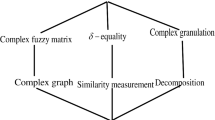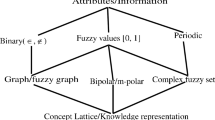Abstract
The m-p olar fuzzy graph representation of concept lattice gives a way to deal with its periodic changes at a given phase of time. One of the suitable examples is opinion of reviewers towards acceptance and rejection of a manuscript used to change several times for a given journal. Dealing with these types of m-polar complex fuzzy attributes is a crucial task for the data analytic researchers. The first problem arises with its precise mathematical representation and second with its algebraic processing for knowledge discovery tasks. In this regard, the calculus of complex multi-fuzzy set and its granulation is introduced for handling complex multi-fuzzy context and its graphical traversal. The information obtained from the proposed methods is also analyzed with recently introduced mathematical model on m-polar fuzzy set as well as complex fuzzy concept lattice.



Similar content being viewed by others
Notes
References
Akram M, Younas HR (2017) Certain types of irregular \(m\)-polar fuzzy graphs. J Appl Math Comput 53(1–2):365–382
Ali M, Smarandache F (2017) Complex neutrosophic set. Neural Comput Appl 28(7):1817–1834
Al-Qudah Y, Nasruddin H (2017) Operations on complex multi-fuzzy sets. J Intell Fuzzy Syst 33(3):1527–1540
Al-Quran A, Nasruddin H (2018a) The complex neutrosophic soft expert set and its application in decision making. J Intell Fuzzy Syst 34(1):569–582
Al-Quran A, Nasruddin H (2018b) The complex neutrosophic soft expert relation and its multiple attribute decision-making method. Entropy 20(2):101. https://doi.org/10.3390/e20020101
Bravo G, Farjam M, Grimaldo Moreno F, Birukou A, Squazzoni F (2018) Hidden connections: network effects on editorial decisions in four computer science journals. J Informetr 12(1):101–112
Broumi S, Deli I, Smarandache F (2015) N-valued interval neutrosophic sets and their application in medical diagnosis. Crit Rev Cent Math Uncertain Creighton Univ U S A 10:46–69
Broumi S, Assia B, Smarandache F, Talea M, Ali M, Selvachandran G (2017) Complex neutrosophic soft set. In: 2017 FUZZ-IEEE conference on fuzzy systems, Naples, Italy, 9–12 July 2017
Broumi S, Bakali A, Talea M, Smarandache F, Singh PK, Ulucay V, Khan M (2019) Bipolar complex neutrosophic sets and its application in decision making problem. In: Irem Otay et al. 2019, Fuzzy multi-criteria decision making using neutrosophic sets. Stud Fuzziness Soft Comput 369: 677–702
Burusco A, Fuentes-Gonzalez R (1994) The study of the L- fuzzy concept lattice. Matheware Soft Comput 1(3):209–218
Cai M, Li Q, Lang G (2017) Shadowed sets of dynamic fuzzy sets. Granul Comput 2(2):85–94
Chen SM, Chang YC (2016) Weighted fuzzy rule interpolation based on GA-based weight-learning techniques. IEEE Trans Fuzzy Syst 19(4):729–744
Chen SM, Huang CM (2003) Generating weighted fuzzy rules from relational database systems for estimating null values using genetic algorithms. IEEE Trans Fuzzy Syst 11(4):495–506
Chen SM, Tanuwijaya K (2011) Fuzzy forecasting based on high-order fuzzy logical relationships and automatic clustering techniques. Expert Syst Appl 38(12):15425–15437
Chen SM, Wang JY (1995) Document retrieval using knowledge-based fuzzy information retrieval techniques. IEEE Trans Syst Man Cybern 25(5):793–803
Chen J, Li S, Ma S, Wang X (2014) m-polar fuzzy sets: an extension of bipolar fuzzy sets. Sci World J. https://doi.org/10.1155/2014/416530 (Article ID 416530)
Cheng SH, Chen SM, Jian WS (2016) Fuzzy time series forecasting based on fuzzy logical relationships and similarity measures. Inf Sci 327:272–287
Dick S, Yager RR, Yazdanbakhsh O (2016) On Pythagorean and complex fuzzy set operations. IEEE Trans Fuzzy Syst 24(2016):1009–1021
Djouadi Y, Dubois D, Prade H (2011) Graduality, uncertainty and typicality in formal concept analysis. In: Cornelis C, Deschrijver G, Nachtegael M, Schockaert S (eds) 35 years of fuzzy sets theory. Springer, Berlin, pp 127–147
El-Omar EL (2014) How to publish a scientific manuscript in a high-impact journal. Adv Dig Med 1:105–109
Ganter B, Wille R (1999) Formal concept analysis: mathematical foundation. Springer, Berlin
Goguen JA (1967) L-fuzzy sets. J Math Anal Appl 18:145–174
Kandasamy WBV, Kandasamy I, Florentin S (2017) Complex valued graphs for soft computing. EuropaNova ASBL Clos du Parnasse, 3E 1000, Bruxelles Belgium
Kroonenberg PM (2008) Applied multiway data analysis. Wiley, Hoboken
Kumar CA, Singh PK (2014) Knowledge representation using formal concept analysis: a study on concept generation. In: Tripathy BK, Acharjya DP (eds) Global trends in knowledge representation and computational intelligence. IGI Global Publishers, Pennsylvania, pp 306–336
Lee LW, Chen SM (2008) Fuzzy risk analysis based on fuzzy numbers with different shapes and different deviations. Expert Syst Appl 34(4):2763–2771
Li JH, Huang C, Qi J, Qian Y, Liu W (2017) Three-way cognitive concept learning via multi-granularity. Inf Sci 378:244–263
Lindig C (2002) Fast concept analysis. In: Ganter B, Mineau GW (eds) ICCS 2000, LNCS, vol. 1867. Springer, Heidelberg. p 152161
Loia V, Orciuoli F, Pedrycz W (2018) Towards a granular computing approach based on formal concept analysis for discovering the periodicities in data. Knowl Based Syst 146:1–11
Mesiarová-Zemanková A, Ahmad K (2014) Extended multi-polarity and multi-polar-valued fuzzy sets. Fuzzy Sets Syst 234:61–78
Nguyen TH, Kandel A, Kreinovich V (2000) Complex fuzzy sets: towards new foundations. Ninth IEEE Int Conf Fuzzy Syst 2:1045–1048
Qamar MA, Nasruddin H (2018) Q-neutrosophic soft relation and its application in decision making. Entropy 20:172. https://doi.org/10.3390/e20030172
Ramot D, Friedman M, Langholz G, Kandel A (2003) Complex fuzzy logic. IEEE Trans Fuzzy Syst 11(4):450–461
Ramot D, Milo R, Friedman M, Kandel A (2005) Complex fuzzy sets. IEEE Trans Fuzzy Syst 10(2):171–186
Sarwar M, Akram M (2017) Novel application of \(m\)-polar fuzzy concept lattice. Math Nat Comput 13(3):261–287
Sebastian S, Ramakrishnan TV (2011) Multi-fuzzy sets: an extension of fuzzy sets. Fuzzy Inf Eng 3(1):35–43
Selvachandran G, Singh PK (2018) Interval-valued complex fuzzy soft set and its application. Int J Uncertain Quantif 8(2):101–117
Selvachandran G, Maji PK, Abed IE, Salleh AR (2016) Relations between complex vague soft sets. Appl Soft Comput 47:438–448
Singh PK (2017a) Complex vague set based concept lattice. Chaos Solitons Fractals 96:145–153
Singh PK (2017b) Three-way fuzzy concept lattice representation using neutrosophic set. Int J Mach Learn Cybern 8(1):69–79
Singh PK (2018a) Interval-valued neutrosophic graph representation of concept lattice and its (\(\alpha, \beta, \gamma \))-decomposition. Arab J Sci Eng 43(2):723–740
Singh PK (2018b) \(m\)-polar fuzzy graph representation of concept lattice. Eng Appl Artif Intell 67:52–62
Singh PK (2018c) Concept lattice visualization of data with \(m\)-polar fuzzy attribute. Granul Comput 3(2):123–137
Singh PK (2018d) Complex neutrosophic concept lattice and its applications to Air quality analysis. Chaos Solitons Fractals 109:206–213
Singh PK (2018e) Three-way n-valued neutrosophic concept lattice at different granulation. Intell J Mach Learn Cybern 9(11):1839–1855
Singh PK (2019a) Multi-granular based n-valued neutrosophic contexts analysis. Granul Comput Springer. https://doi.org/10.1007/s41066-019-00160-y
Singh PK (2019b) Complex vague contexts analysis using Cartesian products and granulation. Granul Comput Springer. https://doi.org/10.1007/s41066-018-0136-z
Singh PK, Gani A (2015) Fuzzy concept lattice reduction using Shannon entropy and Huffman coding. J Appl Non Class logic 25(2):101–119
Singh PK, Kumar CA (2012) A method for decomposition of fuzzy formal context. Proc Eng 38:1852–1857
Singh PK, Kumar CA (2014) Bipolar fuzzy graph representation of concept lattice. Inf Sci 288(2014):437–448
Singh PK, Selvachandran G, Kumar CA (2019) Interval-valued complex fuzzy concept lattice and its granular decomposition. In: Kalita J, Balas V, Borah S, Pradhan R (eds) Recent developments in machine learning and data analytics. Adv Intell Syst Comput 740:275–283
Smarandache F (2013) \(n\)-valued refined neutrosophic logic and its applications to physics. Progr Phys 4:143–146
Tamir DE, Rishe ND, Kandel A (2015) Complex fuzzy sets and complex fuzzy logic: an overview of theory and applications. In: Tamir DE, Rishe ND, Kandel A (eds) Fifty years of fuzzy logic and its applications. Springer, Cham, pp 661–681
Ulazeez AbD, Alkouri M, Salleh AR (2014) Complex fuzzy soft multisets. The 2014 UKM FST postgraduate colloquium. In: Proceedings of 2014 AIP conference, vol 1614. pp 955–961
Ward M, Dilworth RP (1939) Residuated lattices. Trans Am Math Soc 45:335–354
Wille R (1982) Restructuring lattice theory: an approach based on hierarchies of concepts. In: Rival I (eds) Ordered sets. NATO Advanced Study Institutes Series 83:445–470
William-West TO, Singh D (2018) Information granulation for rough fuzzy hypergraphs. Granul Comput 3(1):75–92
Wu WZ, Leung Y, Mi JS (2009) Granular computing and knowledge reduction in formal context. IEEE Trans Knowl Data Eng 21(10):1461–1474
Yazdanbakhsh O, Dick S (2018) A systematic review of complex fuzzy sets and logic. Fuzzy Sets Syst 338:1–22
Zadeh LA (1965) Fuzzy sets. Inf Control 8(3):338–353
Zhang G, Dillon TS, Cai KY, Ma J, Lu J (2009) Operation properties and \(\delta \)-equalities of complex fuzzy sets. Int J Approx Reason 50:1227–1249
Zhao ZQ, Ma SQ (2016) Complex fuzzy matrix and its convergence problem research. In: Cao et al. (eds) Fuzzy systems & operations research and management. Springer International, Cham, Switzerland 2016, pp. 157–162
Zhi H, Li JH (2018) Granule description based on positive and negative attributes. Granul Comput Springer. https://doi.org/10.1007/s41066-018-0113-6
Acknowledgements
Author thanks each of the reviewers and editor’s for their valuable suggestions.
Author information
Authors and Affiliations
Corresponding author
Ethics declarations
Conflict of interest
Author declares that there is no conflict of interest for this article.
Additional information
Publisher's Note
Springer Nature remains neutral with regard to jurisdictional claims in published maps and institutional affiliations.
Rights and permissions
About this article
Cite this article
Singh, P.K. Complex multi-fuzzy context analysis at different granulation. Granul. Comput. 6, 191–206 (2021). https://doi.org/10.1007/s41066-019-00180-8
Received:
Accepted:
Published:
Issue Date:
DOI: https://doi.org/10.1007/s41066-019-00180-8




